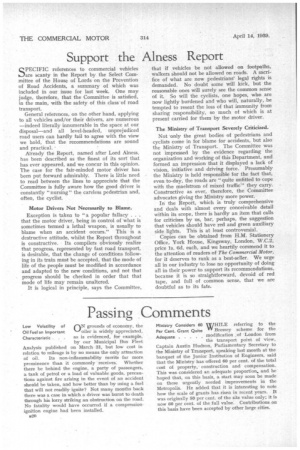Passing Comments
Page 30

Page 31

If you've noticed an error in this article please click here to report it so we can fix it.
Low Volatility of ON grounds of economy, the Oil Fuel an Important oiler is widely appreciated, Characteristic . . . as is evidenced, for example, by our Municipal Bus Fleet Analysis published on March 31, but low cost in relation to mileage is by no means the only attraction of oil. Its non-inflammability merits far more prominence than it commonly receives. Whether there be behind the engine, a party of passengers, a tank of petrol or a load of valuable goods, precautions against fire arising in the event of an accident should be taken, and how better than by using a fuel that will not readily ignite? Not many months back there was a case in which a driver was burnt to death through his lorry striking an obstruction on the road. No fatality would have occurred if a compressionignition engine had been installed.
ie20
WHILE referring to the VY Bressey scheme for the modification of London from the transport point of view, Captain Austin Hudson, Parliamentary Secretary to the Ministry of Transport, speaking last month at the banquet of the Junior Institution of Engineers, said that the Ministry has offered 60 per cent. of the total cost of property, construction and compensation. This was considered an adequate proportion, and he hoped that, on this basis, a start may soon be made an these urgently needed improvements in the Metropolis. He added that it is interesting to note how the scale of grants has risen in recent years. It was originally 50 per cent. of the site value only; it is now 60 per cent. of the full value. Contributions on this basis have been accepted by other large cities.
Ministry Considers 60 Per Cent. Grant Quite Adequate Unhelpful Official Attitude to Use of Producer Gas . .
QUTLINING the preferential treatment given to producer-gas vehicles on the Continent, Mr. H: L.
M.I.Mech.E., the chief engineer of the Coal Utilization Council, said recently, that as a result there were, in 1937, 4,436 gas vehicles in France and 1,207 in Germany, whilst at the present time Sweden has 70 and Italy 1,500. Russia, it is understood, plans to build 16,000 gas lorries and 9,000 gas tractors this year, and 40,000 and 15,000 respectively in 1940. In Great Britain, with its vast coal resources, the Government does just nothing to help.
Interesting Points on THE importance of proper
Tyre Use and Contyr e inflation w a s struction . . . emphasized by Mr. W. B.
Stokes, of the Dunlop concern, in a recent lecture to the C.M.U.A. at Birmingham. He mentioned that in one test a giant tyre was run at 70 instead of 90 lb. per sq. in. This caused an increase of ed. on every pound spent on fuel, whilst
the tyre wear was increased 30 per cent. Incidentally, the new material, Duracord, which is used for making casings -of artificial silk, instead of cotton, stands up much better to rough surfaces such as are found in quarries. Tests with tyres at a temperature higher than 100 degrees C. have shown no damaging effect.
Extent and Value of A N idea of the huge quanti a Vehicle Maker's r-Ities of materials purchased
Purchases •. . . by a big motor-vehicle maim
' facturer can be gained from figures compiled by the Ford organization. These show that, last year, the Ford works at Dagenham purchased British steel to the value of £900,000; iron ore at over £373,000; coal, £316,000; forgings, £315,000; pressings, £80,000; timber, £32,000; limestone and sand (used in the smelting of iron), £27,000 and £10,000 respectively; brass and copper, £29,000; and tin, £6,640. Even upholstery and interiortrimming materials involved £200,000, and paint £37.000. Bolts and nuts, which some might consider to be minor items, meant an outlay of £65,000.




















































































